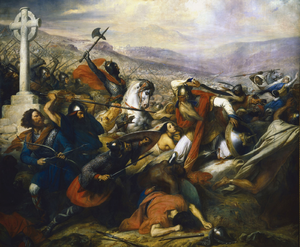
Back الفتح الإسلامي للغال Arabic فتح الغال ARZ উমাইয়াদের গল আক্রমণ Bengali/Bangla Invasió musulmana de la Gàl·lia Catalan Fränkisch-arabischer Konflikt German Invasión musulmana de la Galia Spanish تهاجم امویان به گل Persian Invasion omeyyade en France French Invasi Galia oleh Umayyah ID ウマイヤ朝のガリア侵攻 Japanese
| Umayyad invasion of Gaul | |||||||||
|---|---|---|---|---|---|---|---|---|---|
| Part of early Muslim conquests and the Reconquista | |||||||||
 1837 painting by Charles de Steuben of the Battle of Tours (732), depicting a triumphant Charles Martel (mounted) facing Abd al-Rahman al-Ghafiqi (right). | |||||||||
| |||||||||
| Belligerents | |||||||||
|
Francia Aquitaine Gascony Lombard Kingdom | |||||||||
| Commanders and leaders | |||||||||
|
Al-Samh ibn Malik al-Khawlani † Abd al-Rahman al-Ghafiqi † Yusuf ibn Abd al-Rahman al-Fihri | |||||||||
Islamic conquest of Gaul, also known as the Islamic invasion of Gaul, refers to a series of military campaigns by Muslim forces to expand their territory into Gaul (modern-day France) following their successful conquest of the Iberian Peninsula (Al-Andalus). In some sources, particularly those with a nationalist tone, it is referred to as the Arab conquest of Gaul, although the Muslim army was composed of Arabs, Berbers, and other ethnicities. Other designations include the Islamic conquest of Southern France or Islamic conquest of Gaul.
After the Muslims completed their conquest of Al-Andalus in 711, the next stage of expansion was motivated by the need to secure these gains. Some of the remaining Visigothic nobles, who had ruled in Iberia, had fled northwards and taken refuge in Septimania, a province in southern Gaul. To eliminate their influence and protect the southern Iberian frontier, Muslim forces began a campaign into Septimania.
In the early 720s, Muslim armies advanced into Gaul, capturing strongholds and cities in Septimania, including Narbonne, and moving into the wider region of Aquitaine. Several cities and local populations, disillusioned by their feudal rulers, welcomed the Muslim forces, hoping for liberation from oppressive governance.
Muslim forces continued their northward push, reaching as far as the outskirts of Paris. The rapid Muslim advance alarmed the Frankish princes, who united under the leadership of Charles Martel, the mayor of the Frankish court. In 732, the Muslim forces were decisively defeated at the Battle of Tours (known in Arab sources as the "Battle of Tours"). This defeat marked a turning point in the Islamic expansion into Europe.
Despite the defeat at Tours, Muslim forces continued to occupy parts of Gaul, capturing cities like Avignon, Lyon, and Autun. However, their control was short-lived, and by 759 AD, they had lost Septimania. The final blow came when the Franks, led by Pepin the Short, besieged Narbonne. After approximately 40 years of Muslim rule, the garrison and the local population, including converts to Islam, retreated to Al-Andalus.[1]
After the fall of the Umayyad Caliphate and the rise of the Abbasid Caliphate, internal conflicts within Al-Andalus, including revolts and the establishment of the Emirate of Córdoba under Abd al-Rahman I, shifted the focus of Muslim leaders towards internal consolidation. However, sporadic military expeditions were still launched into Gaul. Some of these raids resulted in temporary Muslim settlements in remote areas, but they were not integrated into the Emirate's authority and soon vanished from historical records.
During the reign of Almanzor, the last notable attempts to expand into Gaul were made, but they were largely unsuccessful. Following the collapse of the Umayyad Caliphate and the fragmentation of Al-Andalus into smaller taifa kingdoms, the Muslim presence in Gaul came to an end.
The Islamic conquest of Gaul had a lasting cultural influence on the region. The Occitan language, spoken in parts of southern France, was notably influenced by Arabic. Moreover, the campaigns contributed to shaping the Christian narrative, which later played a role in motivating the Crusades centuries later.
- ^ Tricolor and crescent: France and the Islamic world by William E. Watson p.1 Archived May 01, 2016 at the Wayback Machine.